by Kevin Killough
Michigan Gov. Gretchen Whitmer appeared, with good reason, on Democrats’ short-list of possible 2024 presidential nominees following President Biden’s halting June 27 debate performance.
Whitmer is the governor of a battleground state that is essentially a must-win for Biden and GOP challenger Donald Trump, an abortion-rights advocate in a race in which abortion is a key voter issue, and is known for having worked across the aisle during her roughly 14 years in the state legislature.
In addition, in 2022 she won reelection and flipped both chambers in the Michigan legislature to the Democrats.
However, her state’s policies on energy, another important election-year issue, could present challenges in any efforts to win crossover voters and the White House.
Under her leadership, Michigan has adopted an aggressive and expensive net-zero target – to use renewable sources or capture carbon emissions – while residents pay some of the highest rates in the region and deal with a poor reliability record.
There is also the matter of Whitmer and her family being the targets of an October 2020 kidnapping plot in which she has implicated Trump, who was still president at the time.
She accused him of “inspiring and incentivizing domestic terrorism.” Whitmer also argued with Trump over the federal government’s response to the pandemic.
Pulitzer Prize winning New York Times columnist Nicholas Kristof made the case for Whitmer replacing Biden, arguing that she’d shore up a win for the swing states, including Michigan.
Left-of-center political scientist and professor Dr. Roger Pielke Jr. argued that she’s “pretty much a bad ass” who offers up electoral advantages and has a good record.
Chet Atkins, a former Massachusetts Democratic congress, who’s now a lobbyist in Boston, recently wrote, “How can you not love a Governor who is affectionately called ‘Big Gretch’ by Detroit rappers, a Governor who faced down a kidnap attempt, and passed gun safety legislation in response.”
The Atlantic was questioning Whitmer last year about a possible run for president, and she made no commitments.
Whitmer, a co-chair of the Biden-Harris campaign, told the Associated Press on Monday that she would not run this year, even if Biden were to step down, and she distanced herself from campaigns – including one called “Draft Gretch” – seeking to make her Biden’s replacement.
However, should she and Biden change their minds, or should she run successfully in 2028, she would likely bring her energy policies to Washington, D.C.
Net zero
Michigan currently generates 26% of its electricity with coal, 26% with nuclear, 36% with natural gas, and less than 9% with wind and solar.
In November 2023, Whitmer signed into law a package of bills aiming to make the state’s entire economy free of carbon emissions by 2050. This includes an aggressive goal of 100% “clean” electricity generation by 2040. This mix of “clean” energy will be 60% renewable, and then the rest can include nuclear, as well as natural gas generation, so long as it implements 90% carbon capture.
“The dumb thing about that is 90% carbon capture has never been achieved anywhere on the planet. So effectively, that means no natural gas after 2040,” Jason Hayes, director of energy and environmental policy at the Michigan-based Mackinac Center, told Just the News.
According to modeling by the Mackinac Center and the Center of the American Experiment, the package of bills will cost Michigan consumers between $206 and $386 billion.
The low-end estimate is utilizing coal and natural gas power plants fitted with carbon capture until the end of their useful lives, then replacing those with nuclear power plants when they retire. The high-end estimate is a grid running 100% on wind, solar and batteries.
Michigan already pays the highest rates for electricity of any of the Great Lake states.
The 2020 average total retail electricity rate in Michigan, which averages residential, commercial and industrial rates, was 12.37 cents per kilowatt hour. For comparison, Illinois’ average rate that year was 9.56 cents, Indiana’s was 9.75 cents, Ohio’s 9.28 cents, Pennsylvania’s was 9.69 cents, Minnesota’s was 10.84 cents, and Wisconsin 11.22 cents per kilowatt hour. The national average was 10.66 cents per kilowatt hour in 2020.
Kyle Olson, founder of The Midwesterner, told Just the News that Michigan’s utilities regularly raise rates. These rate increase requests are approved by the Michigan Public Service Commission.
“The energy companies are constantly going to the MPSC and asking for rate increases. I think a lot of people are saying, ‘what are we getting for that?’ The data shows that we have the highest rates in the Midwest. We have the most unreliable grid. You want to continue to raise rates? For what?” Olson asked.
Citing a 2023 study by the John Locke Foundation, Olson wrote in The Midwesterner that should Michigan invest hundreds of billions of dollars to achieve its net-zero goals, its total emissions avoidance would be offset by 26 minutes of China’s carbon emissions. If the same policy was deployed across the U.S., China would offset emission reductions in 14 hours.
Reliability
Besides saving consumers money, the lower cost scenario would avoid the potential for blackouts, which would be a regular feature of the 100% wind, solar and batteries plan, Hayes said.
“We would see several outages every year. The worst of them that they modeled was a 61-hour continuous blackout in January,” he also said.
Studies have identified Michigan as one of the worst in the nation for blackouts.
Hayes said a lot of that is the result of aging distribution infrastructure. These are the smaller transmission lines going from substations to homes and businesses. They are vulnerable to the ice storms and thunderstorms that Michigan regularly experiences throughout the year.
Hayes said that state and federal policies direct most investment toward building more wind and solar farms, and the transmission lines to connect them to the grid, rather than shoring up the aging infrastructure that’s causing so many blackouts in Michigan.
“We’re going to take an already bad distribution infrastructure, and lay on top of that bad generation,” Hayes said.
Should the situation not be addressed, Hayes said, Michigan could experience something similar to what happened in Texas during the 2019 Winter Storm Uri, which caused widespread outages and killed hundreds of people.
Olson said that Whitmer’s net-zero goals aren’t factoring in the threats posed by Michigan’s climate, in addition to a lot of other facts that proponents of the plan just gloss over.
“It’s not in touch with reality. You’ve got these sort of progressive dreams of becoming net zero by a certain point, but then you’ve got just the practical reality of living in the Midwest, especially the upper Midwest,” Olson said.
Central control
Local opposition to wind and solar projects is now among the biggest impediments to the climate agenda.
According to the Renewable Rejection Database, which is maintained by energy expert Robert Bryce, there have been over 700 rejections of wind and solar projects in the U.S. this year. That’s up from 66 in 2015.
Whitmer addressed that threat by signing two bills last year that take local authority out of the citing of wind and solar projects and transfer it to the MPSC.
Passing the laws made Michigan the fourth state controlled by Democrats, according to Bryce, that strips rural communities of their zoning authority to give control to state bureaucrats. The others are California, New York and Illinois.
“Gretchen Whitmer doesn’t think that there should be a local decision. She wants that to be made in Lansing by an unelected board,” Olson said. Members of the MPSC are appointed by the governor.
Tudor Dixon, who ran on the Republican ticket against Whitmer in the 2022 Michigan governor race, told Just the News that a solar panel installer recently told her that solar companies are struggling to connect mid-Michigan with solar farms because there are too many farmers in the area.
They don’t want to give up their land, and the companies are looking at what the state can do to help. The suggestion was that the state may invoke eminent domain to take over the land they need.
“This is the kind of stuff in the state of Michigan where we don’t question whether or not she would do that, we just question if there’s any way to fight her,” Dixon said.
There was a voter initiative in Michigan to overturn the laws, but it failed to gather enough signatures.
Olson said that a lot of Democrats who supported the bills are eventually going to have to answer for imposing all these renewable projects on local communities that object to them.
“A lot of these things, especially the turbines, are huge. They’re loud. They’re unsightly, and a lot of people don’t want them. So the fundamental question is, should that be a local decision or should an unelected board in Lansing (the state capital) be able to have the power to tell us as a local community, ‘no, we’re going to put this here,’?” Olson said.
Nuclear friendly
While climate activists have often contradicted their cause by opposing nuclear energy, which produces reliable energy without carbon dioxide emissions, Whitmer has been supportive of including the source in her net zero goals.
Entergy Corp. closed the Palisades Nuclear Power Plant for financial reasons in 2022, a process that was planned and completed over several years.
The plant, on the eastern shores of Lake Michigan, south of Grand Rapids, provided 800 megawatts of power to the state’s grid. During the several years the plant was slated for closure, Hayes said, Whitmer was silent, acting as neither a champion nor opponent of the plan. That changed right before the closure was complete.
“Suddenly, she came out and started saying, ‘Oh, yeah, nuclear is absolutely essential for Michigan’s clean energy future.’ And suddenly she was all on board. But nothing in the nuclear world happens overnight. It takes years or even decades of planning to get anything done,” Hayes said.
Whitmer was part of a bi-partisan coalition that rallied to get the Palisades Nuclear Plant a $1.5 billion federal loan to reopen, which would make it the first shuttered nuclear plant to reopen. The loan came with the blessing of Energy Secretary and former Michigan Governor Jennifer Granholm.
Hayes said it’s likely that Whitmer started looking at what Michigan’s reliability problem would look like with 800 fewer megawatts on the grid. She realized that blackouts would be politically disadvantageous.
“She was slapped in the face with reality,” Hayes said.
Line 5 pipeline
Whitmer and Michigan Attorney General Dana Nessel, also a Democrat, have been vocal opponents of a pipeline, known as the Line 5, which spans the Straits of Mackinac between Lake Michigan and Lake Huron.
The pipeline transports 22 million gallons of crude oil and natural gas liquids under the straits every day. Originally built in 1953, the pipeline has had a number of leaks and become a target, as is the case with all pipelines, of anti-fossil fuel groups. The MSPC approved a $500 million project to encase a protective tunnel around a portion of the pipeline, which now needs approval from the U.S. Army Corp of Engineers. That could take until 2026.
Without the pipeline, the petroleum will be trucked across the strait or shipped by barge, which are less safe than pipe transport. Dixon said the estimated 2,500 trucks that would be needed to transport the products every day would also damage Michigan’s roads, which are already in disrepair. Olson said Whitmer’s opposition is an appeal to environmentalists.
“Closing the pipelines may make you look good to Greenpeace, and these far-left progressive environmental groups, but it’s not practical. And it’s going to have a direct impact on the daily lives of people in Michigan. But she doesn’t seem to be too concerned about that,” Olson said.
Should Whitmer pursue ambitions of the presidency, she will likely be in competition with California Governor Gavin Newsom. Oslon said that her policy decisions are likely a means to out-green Newsom.
“If you look at her behavior and her policy decisions, there’s an argument to be made that she’s trying to keep up with California. And as California goes left, she wants to try and push Michigan left,” Olson said.
– – –
Kevin Killough is a reporter for Just the News.
Photo “Gretchen Whitmer” by Governor Gretchen Whitmer. Background Photo “White House” by AgnosticPreachersKid CC BY-SA 3.0.




